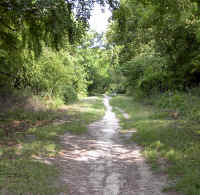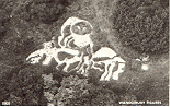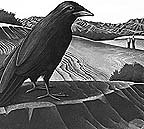The Gog Magog Hills: If these same hills were anywhere else, say in a society similar to India, they would have an elevated spirital and mystical status similar to the holy hill Arunachala, possibly even to the point of Giri Valam, circumabulation. True, there is nothing reported remotely close to the Eight Cardinal Point Lingams as found around Arunachala, but, in it's own ancient English countryside sort of way, there are constant reports of haunting apparitions, ghostly packs of black dogs, giant chalk figures carved into the ground, Vortexes, as well as Ley Lines, and legends of buried golden chariots. If all that was not enough, the surrounding plains as seen from the top of the gentle slopping elevation of the hills has provided striking views of some very fabulous and mysterious crop circles.

Wandlebury Ring, hidden by trees.
Photo © VAR
On these hills to the south-east stands the circular ring monument known as Wandlebury with another earthwork ("War Ditches") to the north-east. Although these two monuments have been interpreted as iron age forts their origins may be considerably earlier. A possible causewayed enclosure lies on the hilltop to the south of Wandlebury, completing the crescent of high land around the site, while a line of barrows runs northwards along the ridge between these monuments. A series of prehistoric routeways run through the general area, west-east from their crossing points on the Cam towards the Icknield Way and the Stour valley beyond, and the north-south Cam-Stort-Lee valley routes between the fens and the Thames.

The Roman Road south-east of
Cambridge where it crosses the
high ground of Gog Magog Hills
The presence of such a site at the base of the Gog Magog Hills adds important new information on what is clearly an unusual landscape with apparently strong symbolic elements. The main elements of the site, interrupted ditches and palisade/fence lines with elaborate entranceway, groups of pits and placed deposits, are all well known elements of late neolithic/early bronze age ritual monuments. The way in which these features divide up the limited space available on the slight rise in the ground where the centre of the site occurs strongly suggests that control of movement and visibility were crucial to the design of the site. An area set apart for human burial, and associated evidence for feasting, further corroborate the ceremonial nature of the site; and its topographical position, flanked by hills on three sides and at a focal point of ancient routeways, makes it a natural choice for location of a special, and perhaps unique monument.
Terence Gray (1895-1986) a millionaire racehorse owner and vineyard proprietor who gained fame, albeit anonymously, some years later as the spiritual writer Wei Wu Wei, once owned the Gog Magog hills but donated the hills and the surrounding property under his ownership to the Cambridge Preservation Trust into perpetuity.

CHALK FIGURES
POWER OF THE SHAMAN
 |
THE BEST OF CARLOS CASTANEDA |
| <<< PREV ---- LIST ---- NEXT >>> | |
|
|

(click image)
HERE FOR
ENLIGHTENMENT

ON THE RAZOR'S
EDGE
Mark Hinman & Tim Malim
Archaeological Field Unit
Cambridgeshire County Council

